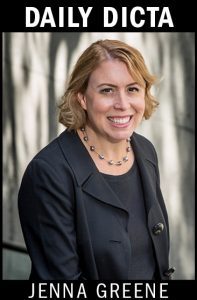Why Michelle Obama Disliked Working at Sidley—and the Lessons That Still Apply
One of the former First Lady's challenges was the isolating nature of the work. “I read memos. I wrote memos. I edited other people's memos.” But she said she had almost no contact with clients, and not much with other lawyers either.
March 04, 2019 at 09:34 AM
7 minute read
 Michelle Obama. Photo: Daniel Acker/Bloomberg
Michelle Obama. Photo: Daniel Acker/Bloomberg
Her buffed walnut desk. Her view from the 47th floor overlooking Lake Michigan. Recruiting law students. The money.
That's what Michelle Obama liked about working at Sidley Austin.
What she didn't like: Everything else.
I've been reading Obama's autobiography “Becoming,” and have been struck by her dismal depiction of the three years she spent as an associate at the firm from 1988 to 1991.
The National Association for Law Placement puts out a periodic report it calls “Keeping the Keepers” about associate retention. Sidley for a brief time employed two of the keeping-est keepers you could imagine: Michelle Robinson and Barack Obama, who met in 1989 when he was a summer associate at the firm.
But both got away.
In hindsight, it seems clear that no matter how nice, how appreciative, how flattering Sidley leaders were to Barack (and according to Michelle, they were very), the 44th president was never going to pursue a career in Big Law. That was not his path.
 But the future first lady? The way she tells it in her autobiography, practicing law simply wasn't for her.
But the future first lady? The way she tells it in her autobiography, practicing law simply wasn't for her.
“I hated being a lawyer. I wasn't suited to the work. I felt empty doing it, even if I was plenty good at it,” Obama wrote.
But reading more closely, there are a few hints that under different circumstances, it might have been otherwise.
Obama has nothing unkind to say about any individual lawyers at the firm. As for Sidley as a whole—which through a spokeswoman declined comment—much of her criticism could apply to virtually any big firm circa 1990.
So what was the problem? And are things much different today?
One of Obama's objections was the isolating nature of the work. “I read memos. I wrote memos. I edited other people's memos.” But she said she had almost no contact with clients, and not much with other lawyers either.
“I craved interaction of any sort,” she wrote. “I had friendly professional relationships with some of the senior partners and perked up at any chance I had to chitchat with my fellow associates, but in general, everyone was overloaded with work and careful not to waste one billable minute of the day. Which put me back at my desk, alone with my documents.”
Obama was a member of Sidley's marketing and intellectual property group (that the two areas were combined is a reminder of the olden days when big firms mostly ceded IP work to boutiques). The group, she wrote, was “considered internally more freewheeling and creative than other groups, I suppose because we dealt at least some of the time with advertising. … I would later be awarded the honor of looking after the legal concerns of Barney the Dinosaur. (Yes, this is what passes for freewheeling at a law firm.)”
According to a 2008 story in The National Law Journal, Obama also “worked on teams that represented AT&T Corp. in its 1990 hostile takeover bid for NCR Corp.and Union Carbide Corp. in its 1990 legal fight to complete a sale of a chemical business unit to Arco Chemical Co. over Federal Trade Commission opposition.”
Her recollection of the Union Carbide work offers a sign that the law could have held her interest. “You wouldn't think I'd be the type of person to find psychic relief in the intricacies of the urethane polyether polyol trade, but I did,” Obama wrote, sounding like any budding litigator diving into a new subject.
But the case settled shortly after trial began, “which meant much of my document reviewing had been for nothing,” she wrote—an experience that she described as “irksome.”
Sound familiar anyone?
She did attempt to get more engaging work, and that's certainly one area where the firm could have done things differently. “I met with the partner in charge of my division, asking to be given more challenging assignments,” Obama wrote.
She doesn't say how the partner responded—but since she subsequently quit to work under Valerie Jarrett for Chicago Mayor Richard Daley, I suspect it didn't happen.
Obama wrote that she also “tried to focus on the projects I found most meaningful, including my efforts to recruit a new and more diverse crop of summer associates.”
Indeed, Obama was clear that she found the overwhelming white-ness of the place off-putting. She mentions that her assistant Lorraine was a “good-humored African American woman several years my senior,” but as for the other lawyers?
“[I]n our office, which employed more than four hundred lawyers, only about five full-time attorneys were African American,” she wrote.
Obama doesn't explicitly say so, but I wonder if some of the isolation she felt—both in the work itself and from her colleagues—might have had something to do with the fact that almost no other lawyers at the firm looked like her or shared her familiarity with “the barbershops, barbeque joints and Bible-thumping black parishes of the far South Side” of Chicago.
But she didn't just complain—she tried to do something to change it.
There's a lengthy passage in her autobiography where Obama describes her ideas to increase law firm diversity, which she made clear was an industry-wide issue, not a Sidley-specific problem.
Obama cited a National Law Journal report that African Americans at big firms in 1990 made up less than 1 percent of partners and not quite 3 percent of associates. (Today, it's 2.09 percent of partners and 4.4 percent of associates, according to NALP's 2018 report on diversity.)
“My goal was to bring in law students who were not just smart and hard-driving but also something else than male and white,” Obama wrote. “I argued insistently—and I'm sure brazenly, in some people's opinion—that the firm cast a wider net when it came to finding young talent.”
That meant recruiting at schools other than Harvard, Stanford, Yale, Northwestern, the University of Chicago and the University of Illinois—where most of the firm's lawyers earned their J.D.s. Obama described it as “a circular process: one generation of lawyers hiring new lawyers whose life experience mirrored their own.”
“I pushed for us to consider law students coming from other state schools and from historically black colleges like Howard University,” she wrote. “I objected anytime a student was dismissed for having a B on a transcript or for having gone to a less prestigious undergraduate program. If we were serious about bringing in minority lawyers, I asserted, we'd have to look more holistically at candidates. We'd need to think about how they'd used whatever opportunities life had afforded them rather than measuring them simply by how far they'd made it up an elitist academic ladder.”
She doesn't say whether Sidley—which last year was squarely in the middle of the pack on the 2018 Am Law Diversity Scorecard, tied for 51st place—embraced her bold-at-the-time ideas to hire more minority lawyers.
I'm guessing the answer is no. In retrospect, it looks like a major missed opportunity.
This passage by Obama strikes me as key: “The point wasn't to lower the firm's high standards,” she wrote. “It was to realize that by sticking with the most rigid and old-fashioned way of evaluating a new lawyer's potential, we were overlooking all sorts of people who could contribute to the firm's success.”
We hope you enjoyed this excerpt from Litigation Daily, the exclusive source for sharp commentary on mega court battles, winning strategies and the issues that obsess elite litigators. Click here to subscribe.
This content has been archived. It is available through our partners, LexisNexis® and Bloomberg Law.
To view this content, please continue to their sites.
Not a Lexis Subscriber?
Subscribe Now
Not a Bloomberg Law Subscriber?
Subscribe Now
NOT FOR REPRINT
© 2025 ALM Global, LLC, All Rights Reserved. Request academic re-use from www.copyright.com. All other uses, submit a request to [email protected]. For more information visit Asset & Logo Licensing.
You Might Like
View All
Processes, Challenges and Solutions In Lateral Partner Integration

Empowering Your Lawyers: A Marketing Team’s Guide to Achieving Goals and Fostering Lawyer Satisfaction
9 minute read
Change Is Coming in the Trump Era. For Big Law, Change Is Already Here
6 minute read
Trending Stories
- 1States Accuse Trump of Thwarting Court's Funding Restoration Order
- 2Microsoft Becomes Latest Tech Company to Face Claims of Stealing Marketing Commissions From Influencers
- 3Coral Gables Attorney Busted for Stalking Lawyer
- 4Trump's DOJ Delays Releasing Jan. 6 FBI Agents List Under Consent Order
- 5Securities Report Says That 2024 Settlements Passed a Total of $5.2B
Who Got The Work
J. Brugh Lower of Gibbons has entered an appearance for industrial equipment supplier Devco Corporation in a pending trademark infringement lawsuit. The suit, accusing the defendant of selling knock-off Graco products, was filed Dec. 18 in New Jersey District Court by Rivkin Radler on behalf of Graco Inc. and Graco Minnesota. The case, assigned to U.S. District Judge Zahid N. Quraishi, is 3:24-cv-11294, Graco Inc. et al v. Devco Corporation.
Who Got The Work
Rebecca Maller-Stein and Kent A. Yalowitz of Arnold & Porter Kaye Scholer have entered their appearances for Hanaco Venture Capital and its executives, Lior Prosor and David Frankel, in a pending securities lawsuit. The action, filed on Dec. 24 in New York Southern District Court by Zell, Aron & Co. on behalf of Goldeneye Advisors, accuses the defendants of negligently and fraudulently managing the plaintiff's $1 million investment. The case, assigned to U.S. District Judge Vernon S. Broderick, is 1:24-cv-09918, Goldeneye Advisors, LLC v. Hanaco Venture Capital, Ltd. et al.
Who Got The Work
Attorneys from A&O Shearman has stepped in as defense counsel for Toronto-Dominion Bank and other defendants in a pending securities class action. The suit, filed Dec. 11 in New York Southern District Court by Bleichmar Fonti & Auld, accuses the defendants of concealing the bank's 'pervasive' deficiencies in regards to its compliance with the Bank Secrecy Act and the quality of its anti-money laundering controls. The case, assigned to U.S. District Judge Arun Subramanian, is 1:24-cv-09445, Gonzalez v. The Toronto-Dominion Bank et al.
Who Got The Work
Crown Castle International, a Pennsylvania company providing shared communications infrastructure, has turned to Luke D. Wolf of Gordon Rees Scully Mansukhani to fend off a pending breach-of-contract lawsuit. The court action, filed Nov. 25 in Michigan Eastern District Court by Hooper Hathaway PC on behalf of The Town Residences LLC, accuses Crown Castle of failing to transfer approximately $30,000 in utility payments from T-Mobile in breach of a roof-top lease and assignment agreement. The case, assigned to U.S. District Judge Susan K. Declercq, is 2:24-cv-13131, The Town Residences LLC v. T-Mobile US, Inc. et al.
Who Got The Work
Wilfred P. Coronato and Daniel M. Schwartz of McCarter & English have stepped in as defense counsel to Electrolux Home Products Inc. in a pending product liability lawsuit. The court action, filed Nov. 26 in New York Eastern District Court by Poulos Lopiccolo PC and Nagel Rice LLP on behalf of David Stern, alleges that the defendant's refrigerators’ drawers and shelving repeatedly break and fall apart within months after purchase. The case, assigned to U.S. District Judge Joan M. Azrack, is 2:24-cv-08204, Stern v. Electrolux Home Products, Inc.
Featured Firms
Law Offices of Gary Martin Hays & Associates, P.C.
(470) 294-1674
Law Offices of Mark E. Salomone
(857) 444-6468
Smith & Hassler
(713) 739-1250








